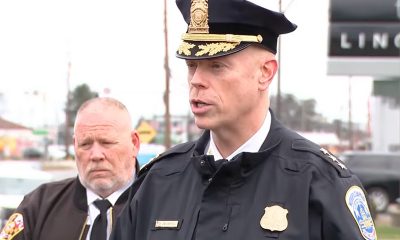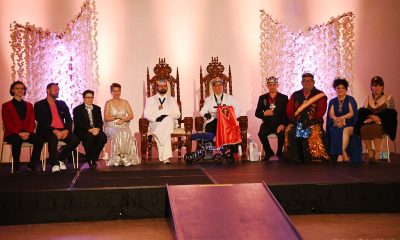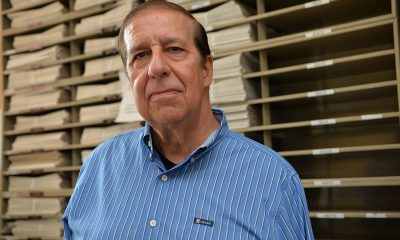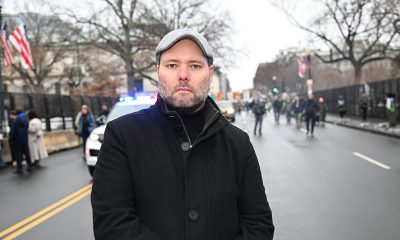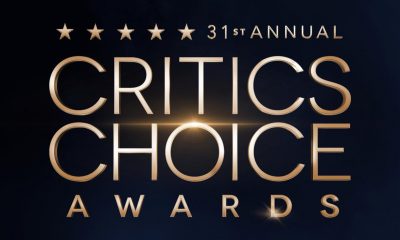a&e features
Salon Roi entrepreneur Roi Barnard reflects on five decades in business
Stylist recalls AIDS epidemic — and Marilyn’s calming presence
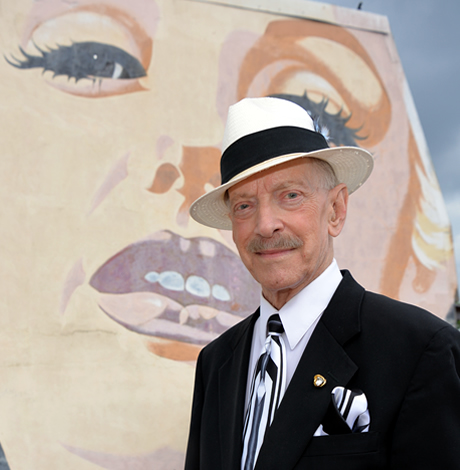
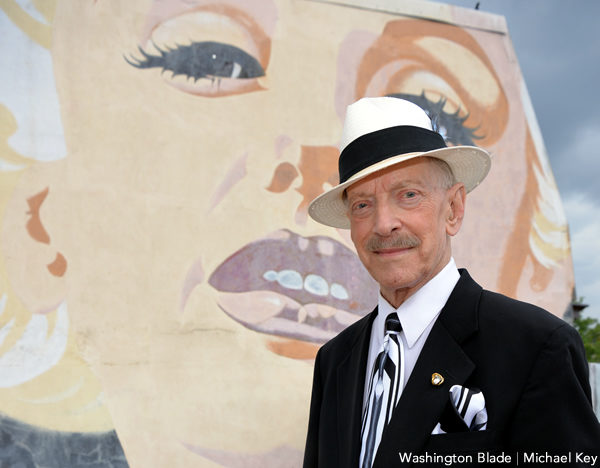
For some — perhaps gay men disproportionately — the draw of a grand staircase is irresistible. Especially if one has logged much time in square-footage-starved city quarters.
Roi Barnard looks proudly around his eponymous salon at the staircase and wall beside it decorated in images of Marilyn Monroe.
“Fifty years I’ve been walking that staircase like Carol Burnett,” he says. “The staircase first sold me on this location. The shop can be whatever you want it to be. It can be elegant because of the staircase. It’s unique and they’re disappearing.”
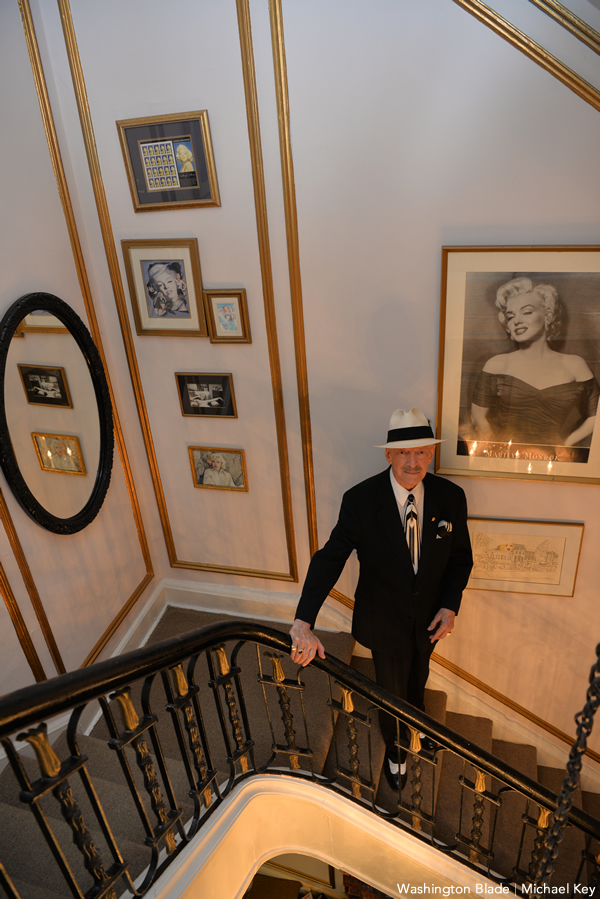
Barnard still works at Salon Roi, though he sold it 12 years ago and has recently cut back his hours since a heart attack. It celebrated its 50th anniversary in business at the same location this month (Aug. 9). Ten years in, the Marilyn mural was created. Now an official D.C. landmark, she’s about to be refurbished. Barnard is celebrating the milestone with the publication of his book “Mister, are you a Lady?” A documentary is also being planned.
Still, it’s Marilyn’s face just as much as his clients who continue to inspire him.
“I first saw her in ‘The Asphalt Jungle’ when I was 10,” he says after having his picture taken in front of her mural painted on his roof. “I remember thinking how sad she looked despite her smile. Like me back then. After she died, I wanted to bring her with me. Now she lives on here.”
For Barnard, the movie legend is more than a mere decorative element. He sometimes speaks of her as if she’s still around.
“We’re going out on the roof for a picture with Marilyn,” Barnard says as he’s halfway out the bathroom window. “Come join us.”
It’s hard to believe this nimble 81-year-old survived not only ’70s excesses, the ’80s AIDS crisis and various waves of conservatism, but also a recent heart attack. He says he did it with his salon and a little help from his friends.
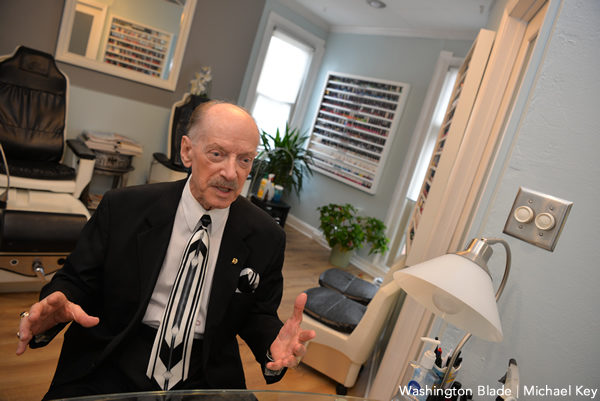
“They’re my family,” Barnard says of his clients and staff. “And those who have been with me from the beginning, we’ve survived a lot. You can see it in their eyes.”
“I would say one part of the attraction of working here for me is not only the beauty of the building but also the family aspect,” says Zakiya St. Rose, a bisexual 28-year-old aesthetician at Salon Roi. “Everyone in my book (of clients) feels loved and cared for, and that’s a part of Roi’s legacy.”
Salon Roi, an upscale salon inside a cozy Woodley Park townhouse, began its life in 1969 as Charles the First, the unisex brainchild of Barnard and his former partner, Charles Stinson.
“We were co-owners and lovers,” Barnard says. “The late ’60s and early ’70s were so incredibly wild. Be glad you weren’t there then because you probably wouldn’t be here now. Times were that wild.”
While Barnard was in a stable relationship and didn’t do drugs, he did enjoy diamond earrings, long fur coats and driving a gold Rolls Royce to Studio 54 on weekends with Stinson. At discos, they would go out on the dance floor and throw up cards in the air granting one free haircut like cost-effective wishes.
“That’s how we got them in,” he says. “We had a big house off 16th street with a big Marilyn Monroe swimming pool. Charles and I were so public and so out there. I was just coming off a fashion modeling career and we were not afraid.”
Still, he remembered challenges, even from gay folks.
“Gay people were afraid of us back then. We had a better time in the straight community,” Barnard says, frowning. “The gay community liked us but were afraid of us because we were out and they could get fired back then, especially if they worked for the federal government.”
Barnard remembers those pre-Stonewall times when, ”We had to hide everything.”
He remembers paying to go to a private party to meet other gay men and a half-hour after he left, it was raided by police. Some of the men he knew had their names printed in the paper and “they were told not to come back to work. They lost everything.”
He and Stinson each married lesbians because, “that was what you did at the time.” But times changed and a taste of freedom led to men wanting more, both gay and straight.
“Half my clientele are straight men,” Barnard says. “They love being pampered. Before the ’60s and ’70s, men didn’t have much choice when they went to the barber. Then suddenly they had a lot more freedom in how to wear their hair. And one cookie leads to a whole box.”
This new desire for freedom led Barnard and Stinson to open a unisex salon. One goal was to spread the love to government workers. Their client lists grew from federal workers to senior officials.
“Why couldn’t we help both men and women?” Barnard says. “Hair is hair. But it caused quite a media frenzy at the time. You see, women went to beauty parlors and men went to barber shops and the twain shall not meet.”
So Barnard and Stinson bucked convention and opened their shop to everyone, but not without controversy.
Barnard recalls being a guest of Maury Povich on D.C.’s “Panorama” and being asked to name-drop his more exclusive clients. He refused. Later, the secretary of defense stopped by his salon to thank him personally. Barnard’s stylists took care of the secretary’s entire family and to this day he is proud to serve the grandchildren of the first children he styled.
“The children saved us,” he says, memories of the AIDS crisis giving him a haunted look.
The repression of the ’50s gave way to the freedom of the ’60s and the flamboyance of the ’70s, but the crisis of the ’80s threatened to take that all away.
“Everybody was scared,” Barnard says. “In those early days people were getting sick, a lot of people, and we didn’t know what was going on. People were losing their shops.”
He seemed unable to shake the fear of the time.
“We still have the same eyes. I can see the ravages of war in the eyes of the girls who survived it with me. I lost five gay male hairdressers — major hairdressers,” Barnard says. “They were up-and-comers. Rising stars. I was mentoring them to open their own shops one day because that is what you do. But then suddenly they got sick and were gone. All of them. Gone.”
He says what happened in his shop happened in many shops in many other cities all over the country. Barnard jokes that before the crisis the term “gay hairdresser” was redundant but afterward, women took control of the industry because they had to.
“We were hit hard in those days,” he says. “Robin Weir, who used to do Nancy Reagan’s hair, had a big salon on P Street. Maybe 25 or 30 hairdressers. He came to say goodbye. So many salons were closing and the owners coming to say goodbye to me.”
He describes how the crisis worsened and how salons started to look like hospital wards as sick stylists kept working despite losing their eyesight, getting tired and having to conceal blotches on their skin.
“No one knew they were dying back then,” Barnard says. “No one knew what was going on. They were just desperately trying to get through their day. You know when you get sick you think you’ll get better and that there is a better day coming, but it didn’t come. For some it never came.”
To help his business survive, Barnard had to make two tough decisions. One was to get an instructor’s license and train all the female assistants “to the once-pompous boys” to do hair.
“Not a single girl got sick,” Barnard says. “It was do that or lose the shop.”
The other was to leave Stinson and buy out his stake in the shop.
“I thought drugs were changing Charles,” Barnard says. “Not a brain tumor caused by AIDS.”
Stinson, Barnard says, was becoming increasingly unstable toward his staff, his clients and his partner. Barnard had to take action, though now older and post-heart surgery he looks back with regret.
“I should have taken him in,” he says looking around the nail room. “I could have let him work here while we watched over him and took care of him. We shouldn’t have left him alone.”
In those early days of the crisis, before Stinson knew he was sick, both he and Barnard were invited to Georgetown University to explain what they knew about gay life. The goal was to learn what about their “lifestyle” was filling the hospital wards with men who should be in the prime of their lives.
“Our secrets were killing us,” Barnard says. “So I told them. I told what I knew.”
Barnard and Stinson took straight but intellectually curious doctors to gay bars around town and told of back rooms where sketchy sex could be had easily “in pitch dark with five, 10 men.”
“At one bar a homeless man walked in off the street,” Barnard says, wrinkling his nose at the memory. “And right into that back room. Even if they couldn’t see him, which was a blessing, they had to be able to smell him, right?”
Barnard’s squeamishness may have saved his life.
He and Stinson introduced the doctors to Jim Graham, the director of a little walk-up clinic on 18th street called Whitman-Walker. Gay men frequented the clinic to treat “VD” or venereal diseases, now called STIs or sexually transmitted infections.
“Jim didn’t like me telling them our secrets,” Barnard says, shaking his head. “But they had to know. We were dying.”
Back rooms began to close, but Barnard felt he needed to do more so he took his styling scissors on the road. He started doing hair for sick young men to help them feel beautiful again. He also joined DIFA, the Designing Industry Fighting AIDS.
But like war nurses who suffer their own forms of PTSD, seeing the constant death began to take its toll.
“One of my beautiful young friends got sick,” Barnard says. “He had these purple spots all over his face. His flesh just hung from him. His skin …”
Barnard was there to cut his friend’s hair but, “I just couldn’t do it.”
“I excused myself to sit alone on his front porch and check in with myself asking, ‘Can I do this? God, please help me.’ I finally told him, ‘I think I’m OK now. I just need some water.’ He asked me, ‘I look that bad?’ And I said, ‘Oh buddy, yeah. Yeah, you do.’”
Barnard styled his hair and warned his friend to take a picture and send it to his family before inviting them out to see him.
Stinson’s condition deteriorated to the point where he wouldn’t last long. Barnard sent him to a friend connected with the Salk Institute for Biological Studies in California. Once known for developing a safe polio vaccine, the institute was now battling AIDS. Though well treated, Stinson would be experimented on before succumbing to the disease.
“Over 300 people came to his funeral,” Bernard says. “Kindness came through.”
As the public learned more about the disease and the death toll eased, business slowly recovered at Salon Roi.
“The fact that we were child-friendly saved us,” he says. “Our children in the ’80s didn’t know about AIDS. They were babies. They are still coming today with their babies.”
The business has now expanded with a spa and other services. Most of the staff still consists of women, but Barnard notes young gay men are returning to the field. Some of the old flair from the ’70s is starting to return as well.
“Now, there is a boy who works here and is extremely flamboyant,” Barnard says. “But he has no idea what we went through before. The lifestyle had to come way down because of the backlash due to the AIDS crisis. But we came through. We survived.”
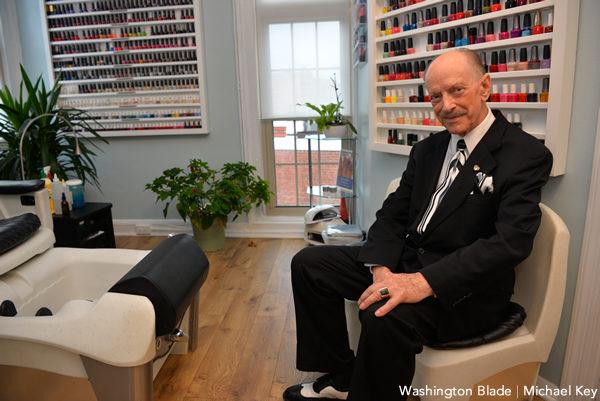
a&e features
Queer highlights of the 2026 Critics Choice Awards: Aunt Gladys, that ‘Heated Rivalry’ shoutout and more
Amy Madigan’s win in the supporting actress category puts her in serious contention to win the Oscar for ‘Weapons’

From Chelsea Handler shouting out Heated Rivalry in her opening monologue to Amy Madigan proving that horror performances can (and should) be taken seriously, the Critics Choice Awards provided plenty of iconic moments for queer movie fans to celebrate on the long road to Oscar night.
Handler kicked off the ceremony by recapping the biggest moments in pop culture last year, from Wicked: For Good to Sinners. She also made room to joke about the surprise hit TV sensation on everyone’s minds: “Shoutout to Heated Rivalry. Everyone loves it! Gay men love it, women love it, straight men who say they aren’t gay but work out at Equinox love it!”
The back-to-back wins for Jacob Elordi in Frankenstein and Amy Madigan in Weapons are notable, given the horror bias that awards voters typically have. Aunt Gladys instantly became a pop culture phenomenon within the LGBTQ+ community when Zach Cregger’s hit horror comedy released in August, but the thought that Madigan could be a serious awards contender for such a fun, out-there performance seemed improbable to most months ago. Now, considering the sheer amount of critics’ attention she’s received over the past month, there’s no denying she’s in the running for the Oscar.
“I really wasn’t expecting all of this because I thought people would like the movie, and I thought people would dig Gladys, but you love Gladys! I mean, it’s crazy,” Madigan said during her acceptance speech. “I get [sent] makeup tutorials and paintings. I even got one weird thing about how she’s a sex icon also, which I didn’t go too deep into that one.”
Over on the TV side, Rhea Seehorn won in the incredibly competitive best actress in a drama series category for her acclaimed performance as Carol in Pluribus, beating out the likes of Emmy winner Britt Lower for Severance, Carrie Coon for The White Lotus, and Bella Ramsey for The Last of Us. Pluribus, which was created by Breaking Bad’s showrunner Vince Gilligan, has been celebrated by audiences for its rich exploration of queer trauma and conversion therapy.
Jean Smart was Hack’s only win of the night, as Hannah Einbinder couldn’t repeat her Emmy victory in the supporting actress in a comedy series category against Janelle James, who nabbed a trophy for Abbott Elementary. Hacks lost the best comedy series award to The Studio, as it did at the Emmys in September. And in the limited series category, Erin Doherty repeated her Emmy success in supporting actress, joining in yet another Adolescence awards sweep.
As Oscar fans speculate on what these Critics Choice wins mean for future ceremonies, we have next week’s Golden Globes ceremony to look forward to on Jan. 11.
a&e features
Looking back at the 10 biggest A&E stories of 2025
‘Wicked,’ Lady Gaga’s new era, ‘Sexy’ Bailey and more

Although 2025 was a year marked by countless attacks on trans rights and political setbacks, the year also saw brilliant queer artists continuing to create art. From Cannes and Sundance Award winners now vying for Oscar consideration to pop icons entering new stages of their careers, queer people persevered to tell their stories through different media.
With the state of the world so uncertain, perhaps there’s no more vital time to celebrate our wins, as seen through some of this year’s top pop culture moments. While there’s no collection of 10 stories that fully encompass “the most important” news, here are some events that got the gays going:
10. ‘Mysterious Gaze of the Flamingo’ wins big at Cannes

The Cannes Film Festival has become a crucial start for films hoping to make their way to the Oscars, and first-time director Diego Céspedes won the top Un Certain Regard prize for his intimate western “The Mysterious Gaze of the Flamingo.” The film is set in the ‘80s and is intended as an allegory for the AIDS epidemic. Seeing a film that unpacks vital queer history win one of the most coveted awards at Cannes has been a huge point of pride in the independent filmmaking community.
Since the film bowed at Cannes, it has been selected as Chile’s Oscar entry in the Best International Feature race. Speaking with The Blade during the film’s AFI Fest run in October, Céspedes said: At first, I was kind of scared to have this campaign position in the times that we’re living [in] here. But at the same time, I think the Oscars mean a huge platform — a huge platform for art and politics.”
9. ‘The Last of Us’ returns for an even gayer season 2
While the first season of The Last of Us gave us one of TV’s most heartbreaking queer love stories in the episode “Long, Long Time,” Season 2 doubled down on its commitment to queer storytelling with the blossoming relationship between Ellie (Bella Ramsey) and Dina (Isabela Merced). The show expanded on the pair’s relationship in the original video game, making it perhaps the central dynamic to the entire season. That unfortunately came with more homophobic backlash on the internet, but those who checked out all the episodes saw a tender relationship form amid the show’s post-apocalyptic, often violent backdrop. For their performance, Ramsey was once again nominated for an Emmy, but Merced deserved just as much awards attention.
8. ‘Emilia Pérez’ sparks controversy
Jacques Audiard’s genre-bending trans musical “Emilia Pérez” proved to be an awards season juggernaut this time last year, winning the Golden Globe for Best Musical/Comedy. But when the lead star Karla Sofia Gascón’s racist, sexist, and homophobic old tweets resurfaced, the film’s Oscar campaign became a tough sell, especially after Netflix had tried so hard to sell Emilia Pérez as the “progressive” film to vote for. Mind you, the film had already received significant backlash from LGBTQ+ audiences and the Mexican community for its stereotypical and reductive portrayals, but the Gascón controversy made what was originally just social media backlash impossible to ignore. The only person who seemed to come out of the whole debacle unscathed was Zoe Saldaña, who won the Oscar for Best Supporting Actress over Ariana Grande.
7. ‘Sorry, Baby’ establishes Eva Victor as major talent
Back in January at the Sundance Film Festival, Eva Victor (known by many for her brand of sketch comedy) premiered their directorial debut “Sorry, Baby” to rave reviews, even winning the Waldo Salt Screening Award. Victor shadowed Jane Schoenbrun on the set of “I Saw the TV Glow,” and seeing Victor come into their own and establish such a strong voice immediately made them one of independent cinema’s most exciting new voices. A memorable scene in the film sees the main character, Agnes (played by Victor), struggling to check a box for male or female, just one example of how naturally queerness is woven into the fabric of the story.
Most recently, Victor was nominated for a Golden Globe for her performance in the film, and she’s represented in a category alongside Jennifer Lawrence (“Die My Love”), Jessie Buckley (“Hamnet”), Julia Roberts (“After the Hunt”), Renate Reinsve (“Sentimental Value”) and Tessa Thompson (“Hedda”). The film also received four Independent Spirit Award nominations overall.
6. Paul Reubens comes out in posthumous doc

While Paul Reubens never publicly came out as gay before passing away in 2023, the two-part documentary “Pee-wee as Himself” premiered back in May on HBO Max, giving the legendary comedian a chance to posthumously open up to the world. Directed by Matt Wolf, the documentary explores how Reubens found his alter ego Pee-Wee Herman and why he kept his private life private.
The documentary won an Emmy in the Outstanding Documentary or Nonfiction Special category and remains one of the most critically acclaimed titles of the year with a 100% Rotten Tomatoes score. Also worth noting, the National Geographic documentary Sally told the posthumous coming out story of Sally Ride through the help of her long-time partner, Tam O’Shaughnessy.
5. Lady Gaga releases ‘Mayhem’
Lady Gaga entered a new phase of her musical career with the release of Mayhem, her seventh album to date. From the frenzy-inducing pop hit Abracadabra to the memorable Bruno Mars duet featured on “Die With a Smile,” seeing Gaga return to her roots and make an album for the most die-hard of fans was especially rewarding after the underwhelming film releases of “House of Gucci” and “Joker: Folie à Deux.” Gaga has been touring with The Mayhem Ball since July, her first arena tour since 2018. She even extended her tour into 2026 with more North American dates, so the party isn’t stopping anytime soon. And Gaga is even set to make an appearance next May in “The Devil Wears Prada 2.”
4. Cynthia Erivo, Ariana Grande perform at the Oscars

While “Wicked: For Good” didn’t quite reach the heights of the first film, we will forever have Cynthia Erivo and Ariana Grande’s breathtaking live performance that opened the 97th Academy Awards. The pair sang a rendition of “Over the Rainbow,” “Home,” and “Defying Gravity,” paying proper homage to the original 1939 “Wizard of Oz.” Even non-Wicked fans can’t deny how magical and brilliantly staged this performance was. With both Erivo and Grande up for acting Oscars last year, they’re hoping to repeat success and make history with consecutive nominations. Either way, let’s hope there’s another live performance in the making, especially with two new original songs (The Girl in the Bubble and No Place Like Home) in the mix.
3. Indya Moore speaks out against Ryan Murphy
Indya Moore has consistently used social media as a platform for activism, and in September, posted a 30-minute Instagram live speaking out against “Pose” co-creator Ryan Murphy. Moore claimed that Murphy wasn’t being a true activist for trans people. “Ryan Murphy, we need you to do more. You need to address the racism, the violence, and the targeting of people on your productions, Ryan Murphy. You do need to make sure trans people are paid equally. Yes, Janet did the right thing,” Moore said. Murphy was also back in the headlines this year for the critically panned “All’s Fair” and the controversial “Monster: The Ed Gein Story” starring Laurie Metcalf and Charlie Hunnam.
2. Cole Escola wins Tony for Best Leading Actor
Few pop culture moments this year brought us together more than Cole Escola winning a Tony award for “Oh, Mary!” the Broadway show they created, wrote and starred in (we love a triple threat!) Escola made history by becoming the first nonbinary person to win a Tony in the leading actor category, and seeing them excitedly rush to the stage wearing a Bernadette Peters-inspired gown instantly became a viral social media moment.
The cherry on top of Escola’s major moment is the recent news that they are writing a Miss Piggy movie with Jennifer Lawrence and Emma Stone producing — news that also broke the internet for the better. We cannot wait!
1. Jonathan Bailey makes gay history as ‘Sexiest Man Alive’

The same year as his on-screen roles in blockbusters “Jurassic World Rebirth” and “Wicked: For Good,” Jonathan Bailey made history as the first openly gay man to be named People magazine’s “Sexiest Man Alive.” The fact that it took 40 years for an openly gay man to earn the title is a signifier of how far we still have to go with queer representation, and seeing Bailey celebrated is just one small step in the right direction.
“There’s so many people that want to do brilliant stuff who feel like they can’t,” he told PEOPLE, “and I know the LGBT sector is under immense threat at the moment. So it’s been amazing to meet people who have the expertise and see potential that I could have only dreamed of.” In 2024, Bailey founded the charity titled The Shameless Fund, which raises money for LGBTQ+ organizations.
a&e features
Your guide to D.C.’s queer New Year’s Eve parties
Ring in 2026 with drag, leather, Champagne, and more
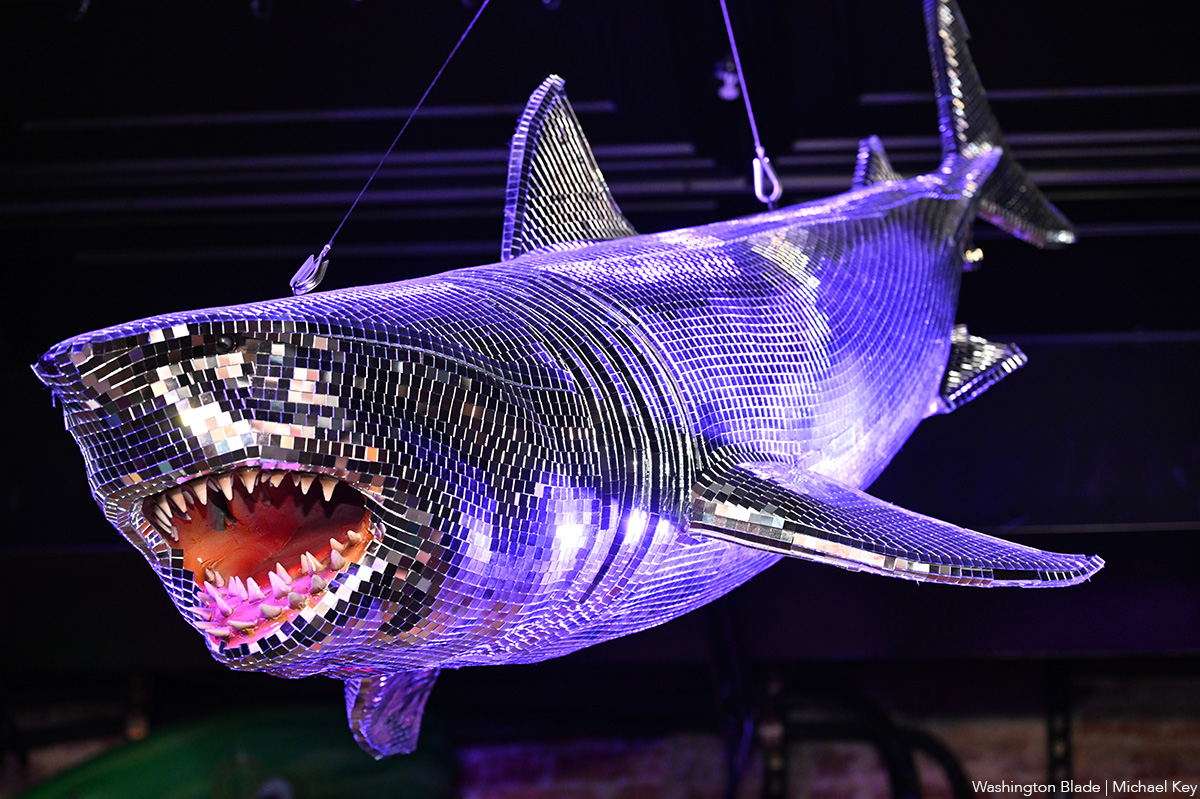
With Christmas in the rear view mirror, we can turn our attention to ringing in a much-anticipated New Year with a slew of local LGBTQ parties. Here’s what’s on tap.
Pitchers
This spacious Adams Morgan bar is hosting the “Pitchers’ Perfect New Year’s Eve.” There will be a midnight Champagne toast, the ball drop on the big screens, and no cover, all night long. The bar doesn’t close until 4 a.m., and the kitchen will be open late (though not until close). All five floors will be open for the party, and party favors are promised.
Trade
D.C.’s hottest bar/club combo is leaning into the Shark motif with its NYE party, “Feeding Frenzy.” The party is a “glitterati-infused Naughty-cal New Year’s Even in the Shark Tank, where the boats are churning and the sharks are circling.” Trade also boasts no cover charge, with doors opening at 5 p.m. and the aforementioned Shark Tank opening at 9 p.m.. Four DJs will be spread across the two spaces; midnight hostess is played by Vagenesis and the two sea sirens sensuously calling are Anathema and Justin Williams.
Number Nine
While Trade will have two DJs as part of one party, Number Nine will host two separate parties, one on each floor. The first floor is classic Number Nine, a more casual-style event with the countdown on TVs and a Champagne midnight toast. There will be no cover and doors open at 5 p.m. Upstairs will be hosted by Capital Sapphics for its second annual NYE gathering. Tickets (about $50) include a midnight Champagne toast, curated drink menu, sapphic DJ set by Rijak, and tarot readings by Yooji.
Crush
Crush will kick off NYE with a free drag bingo at 8 p.m. for the early birds. Post-bingo, there will be a cover for the rest of the evening, featuring two DJs. The cover ($20 limited pre-sale that includes line skip until 11 p.m.; $25 at the door after 9 p.m.) includes one free N/A or Crush, a Champagne toast, and party favors (“the legal kind”). More details on Eventbrite.
Bunker
This subterranean lair is hosting a NYE party entitled “Frosted & Fur: Aspen After Dark New Year’s Eve Celebration.” Arriety from Rupaul Season 15 is set to host, with International DJ Alex Lo. Doors open at 9 p.m. and close at 3 p.m.; there is a midnight Champagne toast. Cover is $25, plus an optional $99 all-you-can-drink package.
District Eagle
This leather-focused bar is hosting “Bulge” for its NYE party. Each District Eagle floor will have its own music and vibe. Doors run from 7 p.m.-3 a.m. and cover is $15. There will be a Champagne toast at midnight, as well as drink specials during the event.
Kiki, Shakiki
Kiki and its new sister bar program Shakiki (in the old Shakers space) will have the same type of party on New Year’s Eve. Both bars open their doors at 5 p.m. and stay open until closing time. Both will offer a Champagne toast at midnight. At Kiki, DJ Vodkatrina will play; at Shakiki, it’ll be DJ Alex Love. Kiki keeps the party going on New Year’s Day, opening at 2 p.m., to celebrate Kiki’s fourth anniversary. There will be a drag show at 6 p.m. and an early 2000s dance party 4-8 p.m.
Spark
This bar and its new menu of alcoholic and twin N/A drinks will host a NYE party with music by DJ Emerald Fox. Given this menu, there will be a complimentary toast at midnight, guests can choose either sparkling wine with or without alcohol. No cover, but Spark is also offering optional wristbands at the door for $35 open bar 11 p.m.-1 a.m. (mid-shelf liquor & all NA drinks).
-

 Sponsored4 days ago
Sponsored4 days agoSafer Ways to Pay for Online Performances and Queer Events
-

 District of Columbia3 days ago
District of Columbia3 days agoTwo pioneering gay journalists to speak at Thursday event
-

 Colombia3 days ago
Colombia3 days agoBlade travels to Colombia after U.S. forces seize Maduro in Venezuela
-

 a&e features3 days ago
a&e features3 days agoQueer highlights of the 2026 Critics Choice Awards: Aunt Gladys, that ‘Heated Rivalry’ shoutout and more



